#knowledge gap
Explore tagged Tumblr posts
Text
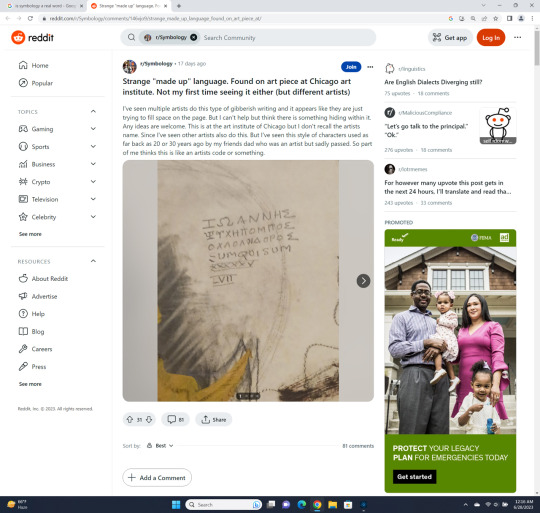
#greek alphabet#greek#latin#roman numerals#john d graham#apotheosis#content#humor#knowledge gap#they weren't trolling
3 notes
·
View notes
Text

I've never been more normal in my life.
[First] Prev <–-> Next
#poorly drawn mdzs#mdzs#wei wuxian#lan wangji#jin zixuan#jiang yanli#Both LWJ and JZX are failing so miserably at the deception check in this scene.#The maneuvers are wild. I am putting them into a petri dish.#LWJ yelling at the guy he's madly infatuated with. Who is earnestly asking what's wrong and trying to bridge the gap between you.#Absolute fumble. No wonder WWX is fully convinced this guy hated him. LWJ was dropping all the wrong signs.#No really. If you have a fraught relationship with someone and they yell at you -#-You can't really walk back from that. All you can do is go 'Oh I make this person *miserable* huh?' and leave them be.#And JIN ZIXUAN. My GUY. What were you doing here? Was it nerves?#Like go you for knowing so many snake facts (that is real by the way I didn't make that up).#And true. Some people really do go wild for knowledge dumps. I am assigning JYL as one of those people. To help him recover the fumble.#JZX being a little bit (a lot bit) lame is probably the best thing for his character. I like him just a bit more for this.
2K notes
·
View notes
Video
youtube
A good video about how women are ignored, discounted, or just not considered in policy, safety, and medicine. Fair warning: The video focuses almost exclusively on cis-gendered men and women, though there is a brief shot of Marsha P Johnson when they talk about women’s contributions being ignored. Essentially it zooms in on part of the gender-inequality problem. It has some really good things to say about that part, but does not address other parts (like non-binary and trans-gendered folks).
#women#gender gap#knowledge gap#sexism (even accidental sexism) still hurts people and makes lives harder than they need to be
0 notes
Text
For a long time I thought Chelm was a fake city, because clearly you wouldn't make up such stories about a real place.....except of course we would. Chelm is like Florida or New Jersey, we all agreed to just keep the joke running.

Jewish village near Chelm, eastern Poland circa 1916-18.
#I was an adult when I learned Chelm was real#I had a college degree when I learned Chelm was real#knowledge gap#Chelm is real
136 notes
·
View notes
Note
Could you draw some cowboy Patrochilles?
More cowboy content coming up right away anon LOL! Patrochilles are the next victims of my new AU
I do not know enough about cowboys to give the, good enough lore but Achilles is probably good at cowboying whatever they do LMAO

#there is a deep gap of knowledge here#anyways#enjoy the cowboy gays#patrochilles#patroclus#achilles#deadbaguettesart#deadbaguettesask
365 notes
·
View notes
Text
Sauron, Galadriel, & Tolkien's Theology of Repentance - Part One

Summary: Character meta analysis on Sauron (and Galadriel, through the lens of Sauron). Based on both Silmarillion & RoP canon. 3.5k words. Discussion of Catholic theology involved. Blanket TW for discussion of violence, manipulation, etc., because Sauron. Spoilers for S1 & S2 and the Silmarillion, of course. The tragedy of Sauron is that he gets offered so many legitimate chances at redemption and forgiveness, and he denies them every single time. But we know he wants absolution, because that’s what he sees Galadriel as: his chance to bind himself back to the light, to be Mairon again, to heal the pain that he caused and that was caused to him under Morgoth. But because he has such a warped view of himself and his actions, he dismisses genuine extensions of compassion, forgiveness, and care as simultaneously beneath him and too good for him. And yet, he still pursues redemption, but through none of the channels offered to him.

In The Rings of Power, he’s given the explicit instruction to change for the good in the village after he’s reborn. He’s given the chance leave his past behind and work meaningfully in Númenor. He’s given the chance to redeem himself by Galadriel's offer of friendship (or love, depending on your interpretation). In the Silmarillion, he's even given the chance by Eönwë himself, and comes close to leaving Morgoth behind completely!
Let's look at this passage from Of the Rings of Power and the Third Age (emphasis mine):
When Thangorodrim was broken and Morgoth overthrown, Sauron put on his fair hue again and did obeisance to Eönwë the herald of Manwë, and abjured all his evil deeds. And some hold that this was not at first falsely done, but that Sauron in truth repented, if only out of fear, being dismayed by the fall of Morgoth and the great wrath of the Lords of the West. But it was not in the power of Eönwë to pardon those of his own order, and he commanded Sauron to return to Aman and there receive the judgement of Manwë. Then Sauron was ashamed, and he was unwilling to return in humiliation to receive from the Valar a sentence, it might be, of long servitude in proof of his good faith; for under Morgoth his power had been great. Therefore when Eönwë departed he hid himself in Middle-earth; and he fell back into evil, for the bonds that Morgoth had laid upon him were very strong.
This passage is clear that Eönwë is willing to pardon Sauron--he simply did not posses the power to do so. But when Sauron was told he must appeal directly Manwë, he gave up entirely and skulked back to Middle-earth. There are a few ways to read this:
1. He was not wholly repentant
Sauron simply wanted the protection of a new master in the absence of Melkor. i.e., he was rather fickle and simply wanted to be on whatever the "winning" side was. This is supported by the text literally saying that at least some of his obeisance was completely false, and that he only made a point of feeling bad about anything once his master had been chucked into the Void and his armies and strongholds were being destroyed (Thangorodrim). In this reading, perhaps Eönwë saw Sauron's treachery and referred him to Manwë knowing that it would be a test of his true intent. However, while a valid interpretation, I believe this to be the less holistic of the two.
2. He was truly repentant
Sauron did truly feel badly and "abjured all his evil deeds," but he was unwilling/unable to humble himself after being so fundamentally broken by Melkor and developing an insatiable power lust (hey, he isn't defined in the narrative by lust and pride for nothing).
Earlier in this same chapter, Tolkien wrote that Sauron could "...deceive all but the most wary." This is in the specific context of his physical shapeshifting. But, I would argue that this can also be tied to his lies. Tolkien has a specific ethic of beauty, where physical perfection is equated with moral goodness. Sauron completely inverts what is otherwise a hard and fast rule within Tolkien's writings by being the character most frequently described as "fair"--seven times to Lúthien's six, and she was the most beautiful woman to have ever lived!
(Side note: I have another post on Tolkien & beauty in the works where I'll get more into this idea)
Why does this matter? Even though this interaction with Eönwë takes place in the First Age, Sauron could at this point be in the demonic form Mirdania describes in the forge. And, I am inclined to believe that Eönwë, as the head Maiar and herald of Manwë, would be a pretty wary guy, and thus able to sense any of Sauron's trickery. I read this to mean that Eönwë looked at Sauron and saw his potential to be Mairon again, either in absence of his evil form or in spite of it.

Because Sauron is incredibly beautiful. And even if it is a disguise of the true, depreciated form of his spiritual essence, he presented himself to Eönwë at his most beautiful. He wanted, even in his act of repentance, to make himself more favorable in Eönwë's eyes. To show up as Mairon (who was likely close friends with Eönwë before everything went down, since they are considered to be two of the most powerful Maia and would have worked closely together).
But I don't think this was all manipulation on Sauron's end. I agree with the scholars mentioned in the text who believed that Sauron was truly repentant--which is why Eönwë even bothered referring him to Manwë instead of kicking him into the Void with Melkor.
And this is the tragedy: Sauron is told exactly how to repent, and believes fundamentally that it is an impossible path for him. And yet, he still longs so intrinsically for it! He was, under Aulë, a Maia of precision, perfection, and order. Under Morgoth, he feels disordered, dis-regulated. He needs to correct the fundamental imbalance within him, so why does he flee Eönwë?
It comes back to Sauron's pride.

If he follows through with this path of reconciliation, there is no way he can hide or pretend his actions away. If he cannot trick his fellow Maiar, he certainly cannot trick the Valar. And he cannot stand the idea of submitting himself back under their rule, especially now that he has tasted power. This is a pride wound; it is why the idea of confessing to Manwë would be humiliating to him as opposed to just upsetting/uncomfortable.
Again, the pivotal moment: he is told how to make amends for crimes and determines that he cannot do it. So he returns to Middle-earth and stews in his own self-hated and self-pity for a few years. In that time, he consciously or subconsciously latches onto Eönwë's offer--forgiveness from penance. It is the way forward. And if he cannot earn penance at Manwë's hand, he will do it on his own.
The Prodigal Son
This is where we have to talk about the Catholic roots of Tolkien's work for a moment. The scene where Sauron approaches Eönwë mirrors the biblical parable of the prodigal son. In this story, a man abandons his family, spends all his money, and falls into ruin. But when he recognizes his failings and returns to his father to get help, he is welcomed back into the family without question--in other words, he is forgiven and restored to his former position.
17 But when he [the prodigal son] came to himself he said, “How many of my father’s hired hands have bread enough and to spare, but here I am dying of hunger! 18 I will get up and go to my father, and I will say to him, ‘Father, I have sinned against heaven and before you; 19 I am no longer worthy to be called your son; treat me like one of your hired hands.’” 20 So he set off and went to his father. But while he was still far off, his father saw him and was filled with compassion; he ran and put his arms around him and kissed him. - Luke 15:11-32, NRSV CE (emphasis mine)
The parallel is clear; Mairon, the repentant Maia, returns home with hopes of reconciliation. He is prescribed the same task that the prodigal son offered to his father: he must be bound in servitude to his father/creator in order to pay off his debts. This is a deliberate allusion from Tolkien. The story of the prodigal son models the path of reconciliation that Eönwë describes. Tolkien seems to be drawing a line in the sand with this: Sauron is unwilling to do the work required by the Valar for repentance, so he is unable to receive the grace of a warm welcome back into the fold of the Ainur. Since he did not humble himself, he has to be told to do it. And he does not want to! He wants to be loved, but he also wants his power--evidence, in a way, of how his character was fundamentally altered in his time with Morgoth.

His pride--and his fear--cut him off from the potential of grace. He does not know for certain that Manwë would subject him to servitude (though I would argue that it's textually evident that it is a custom), but this assumption leads him to flee, which allows him to slip back into his old ways.
He wants to be Mairon (admirable) again, not Sauron (abhorrent). He wants to be accepted and loved, but not punished. He wants the benefits of reconciliation without the work he would have to do to earn it or the shame he would feel as he did. It's pride, but it's also deep shame--the flip side of his extreme ego is an implicit self-hatred, one that we can see in the subtext of how he speaks about himself and about his time with Morgoth.
Even the language Tolkien uses is heavily shame-coded, especially in a Catholic context; Mairon did not go willingly, he was "seduced." He admits to Celebrimbor that he was "tortured by a god". It becomes exceedingly clear through both text and on-screen canon that Sauron was routinely broken and abused for centuries. This has fundamentally damaged his self-perception, which is ultimately what leads him to "[fall] back into evil"--whether due to pride or shame, he hides, perhaps because he consciously or subconsciously does not believe that he deserves forgiveness, no matter how much he craves it.

Naked in the Garden
His flight back to Middle-earth after meeting Eönwë is reminiscent of another biblical scene, where Adam and Eve, after committing the first sin, hide from God in shame and fear (emphasis mine):
7 Then the eyes of both were opened, and they knew that they were naked...9 But the Lord God called to the man, and said to him, “Where are you?” 10 He said, “I heard the sound of you in the garden, and I was afraid, because I was naked; and I hid myself.” -Genesis 7-10, NRSV CE
The image of nakedness is, here, one of vulnerability, and Tolkien establishes that Sauron fears that which he cannot control. He needs the Rings under his power. He needs his armies and his enemies under his watchful eye. He is petrified of letting his power slip away (possibly due to never wanting to feel powerless in the hands of a Vala, fallen or not, again).
The biblical allusion here hearkens back to the fear Tolkien describes Sauron as feeling regarding his return to the Ainur. In the religious system Tolkien has established, which is likely inspired by his own religious beliefs, Sauron has sinned, and must make penance. But he is afraid of God/Manwë, and does not want to "let go" of his sin. In other words, he is not truly repentant. This reflects the Catholic sacrament of confession, which requires self-reflection and resolve to never commit the sin again.
Instead of shame driving him to contrition, it drives him to isolation.
But he still wants forgiveness. So, in his years of hiding in Middle-earth, he decides to earn it himself. His own way.

Enter the Rings.
Sauron wants to perfect the wrong he wreaked so that he can both earn his way back into the Ainur and keep his power. But what he does not realize is that this does not work. Eönwë is clear that he must forsake his true temptation--absolute power--through penance by submission. Yet Sauron in his pride thinks he can have it all. Sauron is a very carefully controlled villain, and the only times he snaps or makes significant mistakes are when his inflated self-perception is challenged, revealing the self-loathing and/or self-pity underneath. The best example of this is when he kills Celebrimbor prematurely, and cries afterwards. Why? Because Celebrimbor was right about him, and he hates it. He hates knowing that he is nothing more than the Morgoth's shadow, because Morgoth was his master as much as he was his tormentor. As Sauron puts it, his relationship with Morgoth was often defined by pain as a test to see "whose will was the mightier":
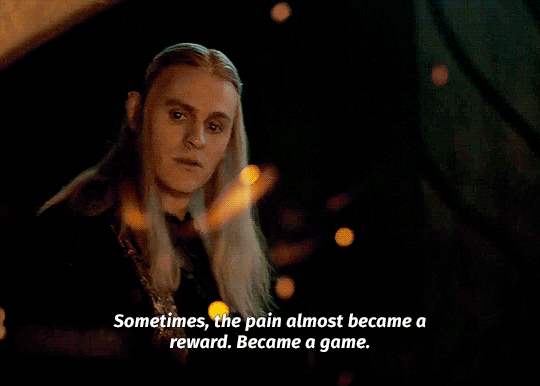
This image carries more shame, both in its implicit sexual connotations and in the simple power dynamic of it. Sauron, even though misguided, is rallying against Morgoth. He wants to break what Morgoth has created and build something new, something better, something apart from his old master entirely. But Celebrimbor confronts him with reality: he has not created something new, and perfect, and special, as he so wanted to--he can only act in imitation, not in generation. And when he got close with the Rings, it cost him everything. It's almost like he wants the power of a Vala, and loathes that he cannot attain it.
And this is why he becomes so singularly obsessed with Galadriel.

She’s his foil. They both crave power and adoration, but in the end of things, she does not fold under his temptation. She turns down everything she has ever wanted for the greater good and for the sake of her own soul. Sauron looks at Galadriel and perceives that she would have succeeded at Eönwë's test because she is willing and able to humble herself. This maddens him to the point of both desiring her and desiring to break her.
She learns that she is easily tempted and becomes strong enough to handle it (through a lot of tough love from Elrond & co.). She has to learn how to do it, but she is able to.
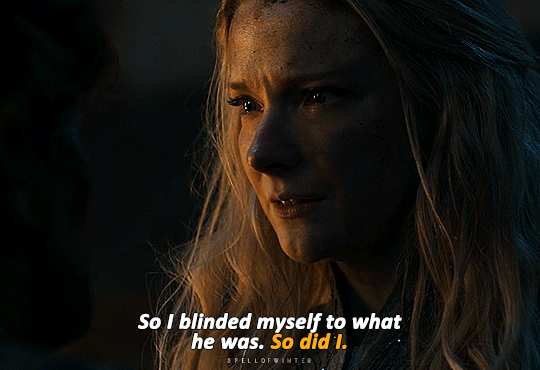

She grows from someone who resisted and rejected authority to someone who is trusted as an authority because of her ability to wield it wisely (see: Gil-galad allowing her to answer for him in 2x08).
In other words, she earns the trust, love, and support of her community. Sauron has to force his to comply—it is an illusion of love.
His possessive obsession with her also stems from her fairness. She was the object of her uncle Fëanor's obsessive desire for creation as well. Her hair was the inspiration of the Silmarils (see: The History of Galadriel and Celeborn; The Shibboleth of Fëanor - source with page #s here), which Morgoth desired more than anything to possess.
Sauron, wanting to spite his master, wants one better--to own that which inspired the Silmarils, to own the image of fairness (and thus of moral good) completely. This is why he wants to bind himself to her. This is why he needs her. He sees Galadriel as his mechanism of repentance, and his last triumph over Morgoth. Winning her is his salvation as much as it is proving that his will is the mightier. It is his way of dominating Morgoth. This starts, I think, as a genuine effort at proving himself to the Valar, but quickly consumes him entirely. He is overcome with the desire for revenge, just as Galadriel was at the beginning of the First Age.
And he sees this in her. Sees their similarities. Sees that she, too, is angry and lonely and so afraid of losing her power. And he leverages that to befriend her. This is where it gets ambiguous and you can read RoP as either painting the image of Sauron being earnest but completely misguided in his proposal, or you can see it as him being entirely manipulative.
I think the truth of that scene probably falls somewhere in the middle; just like when he presents himself to Eönwë, he is sincere in his desire, but only knows how to present it in an inherently contriving way. He does want to bind her to him, so he tries to only reveal to her the good aspect of that desire (and also of his desire for power, which he allows her to see because he believes that it is good and also because she understands it), and not the ugly underside of his internal struggle against Morgoth, the Valar, and himself.
And I do think, in his own way, he cared about her. Galadriel consistently shows kindness and compassion to him. In S1, they grow to know each other's minds and souls, and she considers him a close friend. He finds comfort in this, that someone could see the blackness of his heart and care for him anyway. He thought, in his isolation, that he lost that chance when he fled back to Middle-earth. And here is the very picture of the light itself telling him that she supports him, that she sees the good in him, that she wants to help him set the world to rights! Of course he is infatuated by this. Of course he also wants to use it. He is Sauron.
But Galadriel succeeds where he fails, so he stops playing nice and tries to forcibly drag her down with him. First, by baiting her with the image of the man she cared deeply for:
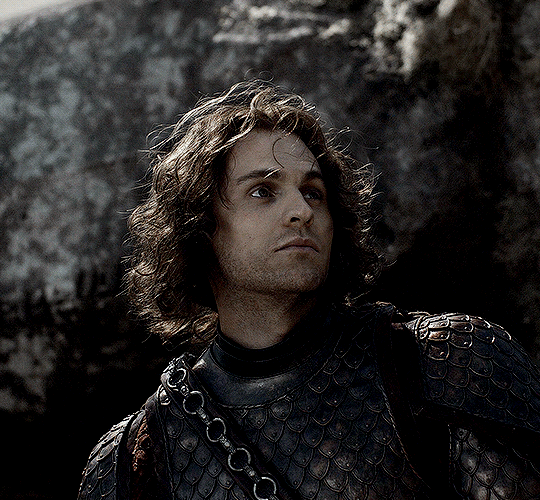
Then, by reminding her of all she is losing by rejecting him:

And she is still strong enough to say no. And not just to say no, but to shut the door completely. To look in the face of everything she has desired for centuries and turn it down, understanding that it will ruin her. Yes, she hesitates. Yes, she still wants it (wants him). But she wins the day by holding fast to the light that Sauron wishes so badly to bind himself to.
Because she has lost everything--her brother, her husband, the station as commander, the trust of her high king and best friend--and earns it back only through her resistance of her greatest temptation. It is a struggle, it is painful, it nearly kills her--but she does it. She wins the test that Sauron could not even bear to face.

In their headlong, self-sacrificial tendencies, they are the same. Both view themselves as fundamentally stronger/better than their peers while also being deeply lonely due to their self-imposed isolation (Galadriel's laser-focused hunt for revenge, Sauron's exile in Middle-earth). But to Galadriel, the light is more important than her pride.
For Sauron, the light is his source of pride. He desires it more than anything, but condemns himself to never being able to touch it due to his rejection of Eönwë's offer. Paradoxically, he tries to grasp at it through Galadriel, the living silmaril, and succeeds only in darkening her. We learn from Gil-galad in 2x08 that his crown piercing her flesh in an act of brutal domination nearly strips her soul from her and pitches it into the unseen world. In this, Sauron is saying: If I cannot have you, I will force you to need me. I will break you into loving me.

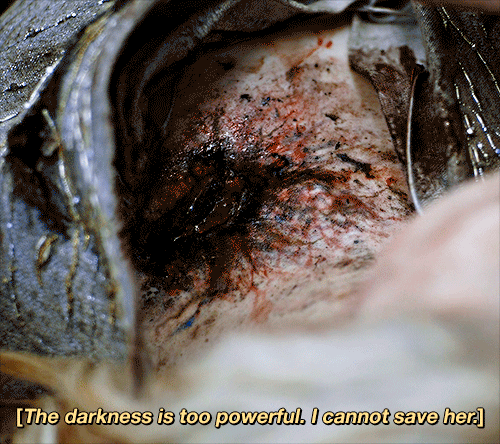
He says this to Celebrimbor as well. He no longer knows how to love properly. He only knows how to inflict pain until this object of his obessive desire needs him--just like how his immortal spirit was broken into submission by Morgoth. And isn't this revealing of his own sense of self? He refuses to suffer the path of light, but willingly suffers the maddening path of darkness because it is a comfortable, familiar suffering. One, he tells Celebrimbor, he even grew to enjoy (2x08). As the path of the Rings drive him madder and madder, his desire for the light (Galadriel) and the return of his power (Celebrimbor) become further disordered and corrupted until they culminate in him destroying them--and his chance at earning/owning them--entirely.

And this is Sauron's ultimate point of no return (which we will hopefully see in S3 🤞). The razing of Eregion and slaying of Celebrimbor were acts of petty rage he committed when his pride was injured. This was the final nail in the coffin. Galadriel, in her rejection of him, ruins what he sees as his true chance for redemption.
Galadriel, now stepping into the role of Eönwë, re-opens the invitation: "Heal yourself!" (2x08). But in rage and shame and stubborn pride, he turns it down again. I believe this is where his desire to heal Middle-earth shifts fundamentally into desire to dominate Middle-earth. He always wanted to rule, but now he wants to own.
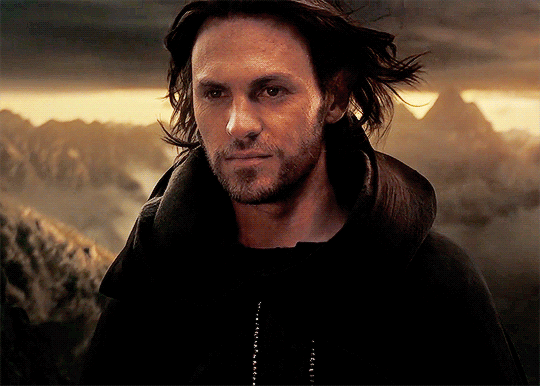
#fae speaks#I spent hours pouring thru the Silm and RoP for this so if you enjoyed please let me know I'd love love love to talk about it more <33#sauron is my favorite freak in all of tolkien's lore rn I want to study him like a bug#btw this is saurondriel (and even silvergifting? if u squint) positive but with loads of nuance. i see haladriel as love and saurondriel as#possession. both are fun in fiction of course but I want to acknowledge how deeply messed up the dynamic is#but also! it's fiction! do whatever you want with it! if you want saurondriel to get a happy ending then do it <3#and send me the fic so i can read it because i'm team half-maia celebrian hehe#also if there are any glaring gaps in my knowledge of the silm pls lemme know it's been a minute since i've read it all the way through#part two will be on beauty and evil in tolkien's cosmology :)#tolkien#the silmarillion#the rings of power#rings of power#trop#rop#sauron#halbrand#annatar#galadriel#sauron x galadriel#saurondriel#haladriel#trop spoilers#trop season 2#trop meta#rop meta#rop theory#trop theory#celebrimbor#my metas
143 notes
·
View notes
Text
MASSIVE PSYOP: Weaponizing fear in Women to Repel cohesive relationships with men... (Soft depop)
Its all fun and games until we all die alone..
In my careful observations, it seems clear that women have a noticeable vulnerability in their minds that men don’t typically have. This can be linked to evolutionary needs, which play a role in how humans reproduce within our complex social structures. It makes sense—and here's where it gets even more interesting—that this perceived weakness helps women engage with potential partners without always seeing through men’s hidden intentions, like simply asking for a phone number. This delicate balance highlights the complexity of human relationships and how reproduction works.
Moreover, historical and religious texts, like the Bible, describe women as supportive partners to men, emphasizing their role in nurturing and cooperation. This background fits well with my conclusion that these built-in psychological traits in women are essential to maintaining and continuing humanity within our complicated societies.
Thus, it becomes evident why women are targeted first when a society is being dismantled. Attacking this cornerstone disrupts the family unit, creating chaos and weakening the social fabric critical to society's stability and continuity.
Disrupt this balance and watch society crumble. You Decide 🤔
#pay attention#educate yourselves#educate yourself#knowledge is power#reeducate yourselves#reeducate yourself#think about it#think for yourselves#think for yourself#do your homework#do your own research#do some research#do your research#ask yourself questions#question everything#divide and conquer#divide the people#gender gap#evil lives here#propaganda#news
75 notes
·
View notes
Text
Nobody including me posts about their ocs enough so please please please reblog reply or whatever with some oc tidbits!
#mutuals I am begging you kindly#I’ll go first! Tango has a massive soft spot for mole rats. hates killing them and thinks that they’re absolutely adorable! they would#rather be electrocuted than to admire that they have feelings though!#Murphy is the second eldest of 5siblings with her twin brother Tom being marginally older#they all look very similar (freckles. light brown hair. tanned#and front teeth gaps) and they have the youngest is tallest / oldest is shortest height variants haha!#they grew up together and stuck together even after the youngest was killed in a battle on Aus soil against fallout china. they all decided#to move to America and enlist (as was common) but we’re all put into seperate squads). the bombs fell and she lost track of her 3 brothers#after the whole being frozen for 210years.. perhaps they are still out there ..#Libby is just over 100 and remembers back when the super mutants actually were an organised threat.. rather than small groups#slick is only an average shot but his tactics are excellent and he has very steady hands as well as enough medical knowledge to be a useful#field doctor! he would much rather be helping than shooting anyway#Thorn is part of tangos timeline/au and because she convinces Kellogg to take her directly to the institute#none of the usual teleporter run around missions happen as well as reunions happening in almost a second time.. that has a lot of#impact on how the story changes for everyone involved!#while nathan is the present time is barely a husk of his former self albeit in a much more dangerous body#he has retains enough of his subconscious memeories to be increasingly dangerous to power armour users.. imagine if when a deathclaw picks#you up it also knows how to operate the release latch rip#typos! ocs tag#typos! tango tag#typos! Murphy tag#typos! Libby tag#typos! slick tag#typos! thorn tag#typos! Nathan tag
81 notes
·
View notes
Text
Why is science actually so cool
#I’m like actually so grateful to have access to all this knowledge omg#A masters is looking so lucrative rn even tho ik I should calm down since I’ll be in school most of my life and could use a gap year
65 notes
·
View notes
Text
if you're struggling to learn via academic texts, consider supplementing some of your learning with lectures
this is a killer intro to surrealism lecture from the university of cambridge
#thoughts#on learning#surrealism#i'm trying to fill gaps in my surrealism knowledge#as i also go more deeply into certain themes/artists
73 notes
·
View notes
Text

Been awhile, crocodile 🐊 In all honesty, I was feeling kind of stressed about character design issues I was having, so for awhile I just put all that stuff aside and focused on understanding anatomy better. Also studied a lot of Milt Kahl animation frames for gesture and simple shapes in character design. I actually had a big grin on my face when I finished these tonight instead of feeling disappointed-- the proportions and shapes feel better, and the hair is more natural in shape and greasy like I always wanted it to be, but kept struggling to draw.
#BSTproject#Jonathan Crane#character design#RA fanstuffs#apologies for not posting much the past few months#kept trying to draw and felt so frustrated with the anatomy knowledge gaps#it's still a work in progress but I'm feeling more optimistic about reaching my goals now#the important thing to remember is not to quit when you reach your limit (even if it feels awful)-- instead take that opportunity to grow.
59 notes
·
View notes
Text
Horses: Since There Seems To Be An Even Wider Knowledge Gap Than I Anticipated
...And actually find it really exciting that I have a reason to expand and address some comments and questions from my first post!
This is a sequel/addition to my original post, "Horses: Since There Seems To be A Knowledge Gap". I want to address more horse-related knowledge gaps, common misinformation and mistakes made by well-meaning and very skilled creators that wouldn't know otherwise unless they worked with horses directly. You should not have to work hands-on with horses to learn some of this stuff, but the fact remains that horse facts and riding knowledge is often underdiscussed and usually only shared by other people that work with/around horses. A lot of this information should be within easier reach for writers and artists, too!
Before I begin, I'd like to thank all of you that politely reached out in the comments, tags, and my DMs/asks with your thoughtful additions to details I forgot/left out/hadn't even considered, and your brave questions posed to me personally that I was more than happy to answer. I'm truly thankful to all of you who contributed with a positive energy, or that had the courage to reach out to me - the OP - with questions my first post didn't manage to help you with. I will never punish, shame, or otherwise mistreat anyone who comes to me with an earnest question or correction in good faith, anonymous or not. If you're polite to me, I will be polite to you. I will try my hardest to answer questions I may not have much experience with, but I will still do my best to research the answers so you don't have to, and tag/cite/refer you to people, books, or other knowledge sources that have more answers and experience than I do if I can't.
So, what more is there to know about writing and portraying horses? I'll just get started off the top of my head with some of the most frequent additions other tumblr horse folk have been hollerin' at me about, and with good reason, because you guys were right to point out what you did and really got me thinking!
-Spurs: My Second Take. In my original post, I voiced my personal distaste for the use of spurs in riding. Spurs, for those who don't know, were traditionally made as sharp metal pinwheels that attached to the back of riding boots for enhanced communication between the rider and the horse, much like how riding crops are used. I, personally, have had a lot of bad experiences seeing riders misuse spurs to hurt horses that I cared for as a stable hand and genuinely loved, and so I've been very shut down about the topic of spurs for many years.
Several people spoke up in defense of spurs as riding and communication tools, and I honestly believe that you guys were very on-point and made some great arguments: Spurs are only as harmful to horses as the intent the rider has in applying them, and I didn't have enough updated information about the different types of spurs that can be used nowadays that are not designed to be sharp or uncomfortable for the horse! I always grew up around traditional Cowboy-style spurs, which are sharp, stabby, star-shaped wheels, and can wound a horse and draw blood if used too aggressively. Tragically, most inexperienced and newer riders will use spurs too forcefully and wind up hurting the horse, and it's largely because new riders are inherently scared of riding, and over-rely on tools like spurs and crops rather than trust the horse to know what it's doing and be intelligent enough to know how to care for a human rider's safety.
Now, I've since learned that there are spurs with rubber wheels, blunted tips like those on the ends of safety-fencing foils, round metal bumpers instead of spurs at all, and even spurs that sport rotating metal balls that just feel (to the horse) like someone rolling a large ball-point pen over their sides, and more! So, to those of you that spoke up in tags and comments, thank you for doing so in a way that got me to open my own mind and check myself and my bad memories. You guys taught me something really cool and valuable that genuinely changed my perspective and opinions, and that's a really good thing!
-A Group Of Zombies/Unarmed Humans Can Take Down A Healthy Adult Horse. This is specifically aimed at The Walking Dead, but... yeah, you know the second episode when Rick rides a horse into the zombie-overrun Atlanta and the only way he's able to survive is when the zombies are distracted taking down and eating his obviously-jello-and-rubber horse?
Yeah, no. That is not how it would happen. At all. I think any biologists in the audience would back me up on that.
See, horses are prey animals, and they are herbivores. We're often used to thinking of herbivorous prey animals as shy, retiring, vulnerable animals that will simply keel over and die of fright when cornered by a predator. In reality, the opposite is often the case! Predatory animals tend to be much more shy, and much more cautious with their physical safety and wellbeing than prey animals tend to be, and that's usually because predators need to be able to remain uninjured and able-bodied enough to hunt again later, or else they and their babies may starve to death. Prey animals, especially herbivores, have evolved to deal with being hunted, and inherently don't need to be quite as healthy and able-bodied as a predator in order to avoid starving in the wild. Grass and leaves don't run away or try to fight back (unless it's like, poison oak or something), so an herbivore can generally recover from more environmental beatings than a predator typically can.
When cornered, horses very often only understand one thing: Murder. That's why you need horse whisperers and stable hands that know how to "gentle" a panicked horse as essential personnel at boarding and teaching ranches. While a horse can absolutely love and adore even the smallest of children and never harm them (at least intentionally - accidents happen), they can and absolutely will kill in order to defend themselves if running isn't an option. Horses can kick with up to 2,000lbs/907kg of force with their back legs. That's enough to break bones, shatter skulls, insta-kill grown men, and if you're kicked in the chest? Cause spontaneous cardiac arrest. Horses kick so hard and so fast they can literally make your heart stop from the speed and force of the impact alone: not from tissue damage. Horses will also paw and stomp with their front hooves until the Threatening Thing is effectively a mincemeat pancake, bite hard enough to take off fingers and hands, and can even cat-jump into the air off all four hooves in order to kick outward with all four legs at once. Spanish cavalry officers traditionally trained their horses to cat-jump on command in order to prevent them and their horse from being surrounded by footsoldiers in battle.
Horses will also use their body weight to roll, crush, scrape, and flatten anything or anyone that they don't want holding onto them. They will use environmental objects like trees, fences, or the corners of buildings to scrape unwanted hangers-on off into bloody smears (my mom's horse actually did this to a guy twice and he wound up in the ER with severe lacerations, bruises, splinters, and worse). Basically: a horse will use its entire body and the weight that comes with it as well as the entire world around it to fucking OBLITERATE anything they see as an unavoidable threat to their safety.
Without heavy-duty ropes, weapons, or tools, a group of adult, living, human men the size of football (the fake kind) linebackers wouldn't be able to successfully wrestle a fully-grown, panicked horse to the ground, much less a bunch of undead, mostly-decomposing zombies that only know how to bite and scratch. The horse Rick is riding on looks like it's probably a Quarterhorse, too. Quarterhorses are very sturdy, moderately-sized breeds that are also the iconic Cowboy Horse. They're tough, they're brave, they're hearty, and if they snap, they can and will kill both other animals and humans.
A horse's skin is so thick and tough that it's virtually impossible for a human to successfully bite or scratch hard enough to puncture through their outer dermal layers. As stable hands, a regular tool we use for getting mud out of a horse's hair is a literal metal wire brush that can rip open our skin if we try to use them, but the horses lean into them without even a hint of damage to their skin from doing so. There may be some tiny welts and a little bit of blood if a human tries to claw and bite at a horse, but horses do far worse to each other when they're just playing! Our fingernails and jaw muscles just aren't strong enough to do much damage to a healthy horse's skin.
-Horses aren't domestic animals.
...Yes they are. But just like other domestic animals, there can be wild populations of them that have had little or no human contact or intervention. Genetically speaking, however, horses are indeed domesticated. They're large domestic animals , but they are very much domesticated. Humans have been working alongside horses for at least 6,000 years. Domestic cats have only been domesticated for about 10,000 years. Truly wild horses in herds today, sadly, are pretty much 100% descended from domesticated horses. The recently-reintroduced-to-the-wild Przewalski's Horse is probably the closest genetic link to the original wild horses native to what are now modern Mongolia and Kazakhstan. Even the revered American Mustang is the product of domestication and planned breeding practices by both white colonists and Indigenous Americans over thousands of years, but Indigenous Americans were capable of maintaining a healthy balance between their personal horses and the essential need for herds of wild horses for the environment, too. White colonists did not understand this and intentionally stripped the North American frontier of its herds of wild horses, and are the primary reason the Mustang is only recently reappearing in wild herds in North America.
Sheep are domestic animals. Cows are domestic animals. Goats are domestic animals. Just because an animal has hooves and doesn't usually live in your house with you does not mean it isn't domesticated: You've just never had to live in an environment where they're essential to daily life or considered welcome companions, so they seem more like wild animals than cats and dogs. Hundreds of years ago, before modern building techniques created houses that could stay sustainably warm year-round, it was very normal for families to bring in cattle as large as horses and cows into their homes and sleep in the same rooms together for security and warmth, dookie and all (horse and cow poop doesn't smell as rank as dog or cat poo; they're herbivores, so it just doesn't smell as foul, and happens to make very good fuel for the fire). We don't do that anymore for health and safety reasons, and so horses, among other farmyard and "rural" domestic animals have become increasingly alienated from most people's psyches as being animals just as capable of being pets as your dog or cat.
-You can calculate how long a horse can run or work every day. This one is largely in response to some well-meaning questions I got from anons that seemed to want me to give them precise hourly work rates and mileage horses can tolerate. I was frustrated by questions like this, because it's a really cool subject to discuss, but not an easy question to answer. Horses are not machines, and "horsepower" is a unit of measurement derived from horses - not applied to them. "Horsepower" is a term used in machinery like tractors and cars. The total horsepower of your average horse is... well, 1, because that's how many horses a single horse can be without getting into some Welcome To Night Vale shit, which I'd love to do, but is a bit too far off topic for this particular post.
A horse's capacity to work or travel is heavily determined by outside factors, as well as organic factors in regards to the individual horse. How old is the horse? How heavy is it? How heavy is the rider? Is it also carrying cargo, like armor and camping supplies? Is it working on a farm and pulling a plow? If so, what quality is the soil? Has it been plowed before? Does the farmer own more than one horse? Is it hot outside? Is the horse going up and downhill? Is it fly season? Is the ground rocky? Are there burrowing animals in the area? Is there clay in the soil? Did it rain recently? How well-kept are the roads? Are there roads to use? What time of year is it- Aaaaaaah!
Ultimately, the answer is: A horse can work as long as it's willing to, and as long as its owner/handler judges is safe for the horse. A horse may be able to pull an old-fashioned plow through well-tilled soil for most of a cool morning before needing a break to cool down, eat, and rehydrate. It takes the judgment of the person commanding the horse when to call for a break or a full-stop to working for that horse by observing how tired it is (is it panting? Sweating? Slowing down? Are there any signs of strain in the hooves or legs?) or if it's in any way injured or in pain. The same applies with traveling long distances: It's up to the rider's judgment and how forgiving the environment is on the horse's body. In some cases, a riding horse may not be able to be ridden safely if the road is too treacherous or uneven for the horse to handle balancing its own weight and the rider's. In those cases, it's better for the rider to get off the horse and gently lead them through the bad terrain until it smooths out.
Also... horses can just... choose to quit. Some are quite sassy or very clear about their boundaries, and if they don't feel motivated or get too bored, they won't cooperate at all. The only way to deal with this is by letting them go do their own thing in the paddock until they decide they wanna cooperate again. Abusive people my try to whip or spur a horse into working past its limits, but humane people just let the guys take a break.
-Two adult people can ride on the same horse for a long time. GOD NO. PLEASE GOD NO. DO NOT DO THIS. PLEASE DO NOT EVER, EVER DO THIS.
Horses can only safely carry a maximum of about 30% of their total body weight on their backs without risking severe spinal damage, if not a broken spine altogether. A Thoroughbred - the iconic racing horse - typically maxes out at about 1,000lbs total in weight as an adult. Thoroughbreds are fairly tall compared to other fast, hot-blooded horses, like Arabians. That means that, at best, a perfectly healthy, not-too-old, not-too-young Thoroughbred horse would not be able to carry a total weight of more than about 450lbs, including the weight of its saddle and other tack, supplies carried by the rider, armor or other gear worn by the rider, and the impacts of gravity and the shocks of the rider's weight on the horse's back when it's moving at any speed. In the vast majority of cases, two adults cannot safely ride on the same horse for more than a very short distance before the horse enters the danger-zone for suffering severe and permanent spinal damage that can result in euthanasia. An adult carrying a baby or toddler is different, but two adults? Please don't. Please. Even if you're getting married and the owner of the super-huge pretty draft horse you're renting to take a gallant shared ride with your spouse with for pictures that reassures you it's fine, do not do it. Please just rent a carriage or pay extra for two horses. Please.
-A paddock with grass is all a horse needs to meet its nutritional needs. If that were true, horses would still be kept as pets more commonly around the world than they actually are. Unfortunately, to really thrive in the wild, horses need hundreds, if not thousands, of hectares of territory they can freely travel around in, while most paddocks are rarely larger than 10-20 acres when you're not talking about generational wealth or land. One of the reasons domestically-raised horses are almost entirely dependent on humans for food is due to the restricted spaces they're kept in. Grass only produces nutrition when the soil itself is fertile, and we humans don't necessarily have the natural ability to sense when soil is too nutrient-deprived for the plant life growing from it to be enough to provide just one horse with the vitamins and minerals they need on a daily basis to be healthy.
Another fact largely lost to history is that, back when most families had to farm to survive, farmers would store green leaves from various healthy and tasty trees and bushes in the boughs of other trees within their cattle paddocks and fields. By doing this, it kept large amounts of pests like rats from infesting the leaves, and keeping the cut branches and leaves stored within other leafy trees actually kept the greens fresher much longer than if they were stored on the ground or in a storage room. Horses would then graze from the leaves in the trees above their heads as well as the grass.
Stable hands and private owners keep rigorous dietary routines tailored to the needs of each individual horse. We're usually up and feeding the horses by dawn at the latest. The horses are usually given a few scoops of oats (not too much, because oats bloat up when they absorb liquid, and too much of that can give a horse colic), carrots and other vegetables for extra vitamins, salt licks (which are infused with extra minerals like a giant multivitamin), and even vitamin tablets/powder that goes straight into their dinner hay or alfalfa. Vets are essential for evaluating a horse's specific nutritional needs, so horses can actually get "prescriptions" for specific ingredients in their regular meals given to us from licensed large animal veterinarians, and not just a wealthy owner's best guess.
-Horses can throw up. Nope! It's not even physically possible for a horse to spit up food! That's part of why stable hands and owners have to be so careful in maintaining a regular, stable, healthy diet for their horses and keep their pastures and paddocks checked for toxic substances like poisonous plants that a horse may not know is toxic, or notice in the grass it's munching on.
Because they have such long necks and tall legs, horses need special muscles in their upper GI tracts in order to graze and drink water without constantly choking and fighting gravity. By having an esophagus that's one-way-only, as well as a muscle that clamps their stomachs shut at the top called a French Tie, horses hold down anything they swallow, even if it's enough to kill them.
-Horses are the best farm animals for a pre-industrial setting. Goodness no! Not at all! In fact, horses didn't start really replacing oxen on farms until the dawn of Draft Horses in the Victorian Era in the West. While many Eastern countries still retain the use of oxen for farming, Western European farmers fell prey to what we all dread: Peer pressure.
When Draft Horses started to appear in the scene in formal horse fancier associations, they were readily advertised as being excellent replacements for oxen (neutered male cows; so, a bull that has no balls). Oxen can be very stubborn, yet affectionate animals, and newer farmers often struggle more with handling oxen compared to horses. The Victorian Era saw a small boom in private farms, and so there became an increasing demand for "easy" farm cattle for newbie farmers to employ.
The other factor that played into horses replacing oxen in Western farming was clout. Horses are more expensive than oxen and generally seen as more prestigious to own. So, farmers often wound up "upgrading" from oxen to horses when their financial means allowed them to. The problem was that, in order to do the same amount of farm work with horses, you need more horses to replace exhausted or injured horses throughout each working day compared to how many more oxen you need to swap out throughout a day of heavy labor. But, nonetheless, horses took over for being "more trainable" and "more intelligent" than oxen (admittedly, oxen can be trickier to work with, but that does NOT mean that horses do a better job at hard field labor), and the Western oxen training industry has almost completely gone extinct.
Really, oxen do a lot better at extremely heavy jobs like tilling and plowing soil for growing crops and hauling large, heavy weights. Because oxen have cloven (two) hooves, they're a lot better at gripping the terrain and avoiding injury to their feet when they're working hard at awkward angles or on rough terrain. Oxen also pack on a lot more muscle and fat around their entire bodies, and so they have fewer vulnerable zones that can become irreparably damaged from exerting a lot of muscle power. Horses, only having a single hoof, can be rendered completely incapable of working or even running just from fracturing a hoof or stepping on a sharp object, like a nail.
-Any leg injury means instant euthanasia. No! No, no, no! There are lots of ways to treat a variety of injuries and illnesses that present in a horse's leg or foot. Especially nowadays, thanks to advances in all forms of prosthetics and 3D printing, horses are euthanized less and less for increasingly severe leg injuries courtesy of prosthetics and mobility aids! Some advances have been made so far that a horse that loses the lower portion of its leg can live a healthy life with a prosthetic!
Don't believe me?
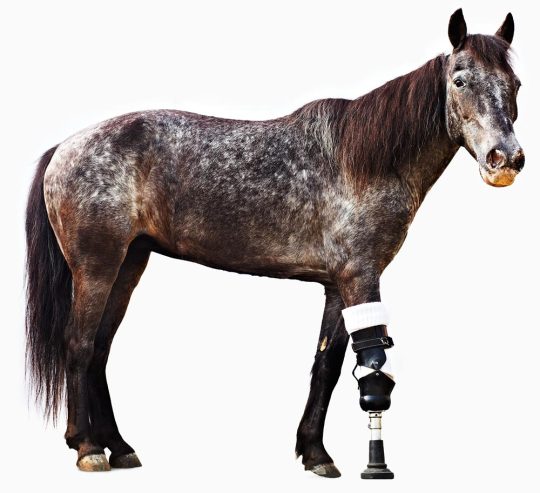
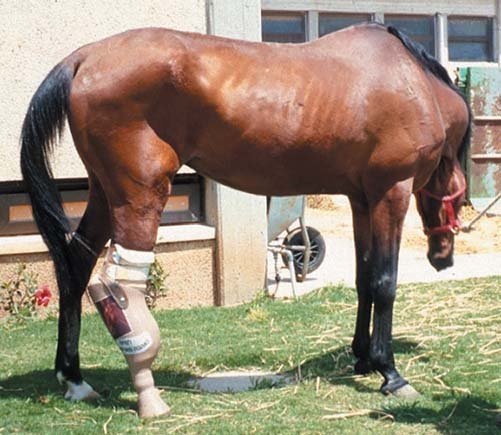
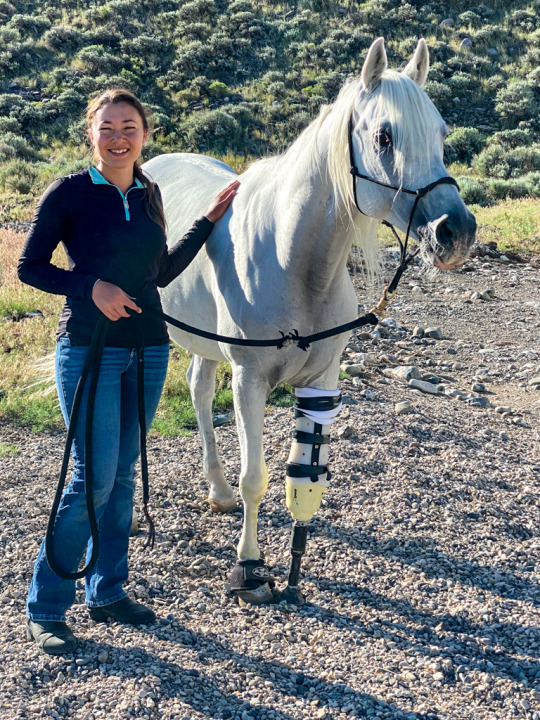
Even in history, there have been treatments for leg and foot ailments for horses used before any talk of euthanasia is brought up. Remember: horses are often beloved service animals to people, today and a thousand years ago! Would you jump straight to euthanizing not only your best friend, but your primary mode of transport, as well as your extraordinarily-expensive ESA?
It's only in cases of severe breaks in a leg bone that injury-related euthanasia is discussed for a horse. Smaller fractures and hoof damage can actually be treated and healed, especially with modern veterinary science, and some fractures can be so successfully treated that a horse can return to riding and competing after recovering!
-Bits are cruel.
Look. There's one person that raked me over the coals in the replies for being ignorant in espousing bits as essential parts of a horse's bridle. I know who you are, and honestly, I feel the compassion you have for the animals... but you're still sipping a little much from PETA's kool-aid and did not convince me over to your side.
Yes, there are bridles that do not require bits to control a horse's head and communicate with it. Yes, there are riders that prefer them, and there are horses that can only be ridden with them due to bad experiences with bit-training or past dental problems. No, it's not cool to tut your fucking finger at me and call me ignorant when I assert that it's a very normal, standard part of tacking up and riding a horse, and the worst a bit can do is pinch the corner of a horse's lip or tongue if you are a jerk with your rein-etiquette. There are bits, just like I observed with spurs, that are specifically designed not to hurt or cause any distress to the horse, so if the person that dumped on me in the last post reads this one: Calm the fuck down and go take yourself on a walk along with your horse. Have an apple. You've clearly been in your stall too long.
As I was saying: Yes, there are different kinds of bits that are specifically designed not to harm a horse. Sometimes horses with smaller mouths or wrinklier lips (it's a thing) can have a hard time with specific bits due many of them sporting hinges where they wrap around out of the horse's mouth and connect to the bridle. This can be easily addressed by switching to a different kind of bit that's less harsh and more flexible for the sake of a horse's comfort, or getting rid of a bit altogether and swapping to bitless bridles. Ironically, I've met horses that actually stim with their bridles; they play with the bits with their tongues when they're excited before an event, kinda like they're grinding their teeth.
And yes, some horses can still have bad sensory issues with bits, and can need bitless bridles, and that's okay! The important thing about bridles in general is that they're the primary way a rider can communicate with the horse's head and show them where they want to go. As with riding, horses tend to go in the direction their heads are facing; they don't usually walk while looking sideways, but rather stand still to look sideways before turning back to the direction they want to go in to walk or run. A lot of riders are taught the phrase, "Head like a princess, hips like a whore," as a reminder to keep their hips loose and moving with the horse, but their heads focusing on where they want the horse to go, rather than looking at the scenery. Most riders, even those that are very experienced, can get distracted and accidentally put a little too much pressure on the horse's bridle and side in the direction of where they're looking, and that causes the horse to go off course, too.
-Horseshoes are incredibly painful and must be replaced only when absolutely necessary. Not at all! A horse's hoof is basically like a gigantic fingernail. While the inner core of the hoof, which is typically concave with a V shape in the middle and needs cleaning by stable hands on a regular basis to keep gunk, debris, and dangerous stuff like nails out of their feet is vulnerable to pain and injury, the rest of the hoof is literally a giant fingernail! A ferrier specializes at grooming a horse's hooves and trimming them so they don't overgrow (which can happen if they spend a lot of time on soft surfaces like grass), and many ferriers also specialize at setting and replacing horseshoes. A horseshoe specifically sits around the outer edge of a horse's hoof - specifically where a hoof is least sensitive and most likely to split or become damaged while riding and lead to infection and pain later - where the horse has no nerve endings. The nails that go into the horseshoe to hold it in place are actually very short and narrow at the tips, and only go into the solid nail a couple of inches into that same nerveless outer edge. The shortest horseshoe nails I've seen used are only 1.5 inches, or 4cm, and the largest around 2 inches, or 5cm and the worst a horse feels when a shoe is being set or replaced is a dull thudding from the tapping of the small hammer used to set the nails. A horse can literally go right back to business after their shoes are fitted, although a ferrier may recommend having them spend some quiet time in their stall for a couple of hours to really make sure the shoes are set properly and the horse is comfortable if something like a trip caused the original shoe to come off (the technical term is "casting a shoe").
My evening meds are kicking in, so I'll stop this very, very long sequel here.
As before, feel free to send me asks with more questions. I'm sure there are even more things I'm too sleepy to remember right now, and this post is running incredibly long.
#horses#horseback riding#writing tips#writing#long post#sequel post#horses: since there seems to be a knowledge gap#god this is gonna turn into a series isn't it
46 notes
·
View notes
Text
hello music enthusiasts of tumblr!
does anyone happen to know of any academic sources that discuss specific styles of hip hop and rap (such as: how early 80s hip hop is has its own distinct style when compared to that of the 90s and that of the 2000s and into the 2010s) as well as any sources that discuss the global diffusion of rap, (and, only if you happen to know of a source) how it got to South Asia
for those that were in tune with the pop culture and music scene of the 2000s/2010s, how would you all classify Akon? Would it be best to describe him as a rapper popular throughout the 2000s, or more so late 2000s/early 2010s?
thank you in advance!!
#academia#studyblr#music#most of the papers I have been able to find thus far are about different opinions of rap within the United States#and I will continue doing my own research but of course just wanted to ask here in case anyone has anything :)#when I listen to hip hop and rap I tend to listen more to hip hop from the 1980s (I adore the style!!) thus this is one of the gaps in my#knowledge I am trying to remedy#(and I am writing a paper on 2-3 specific songs from a particular movie)
27 notes
·
View notes
Photo

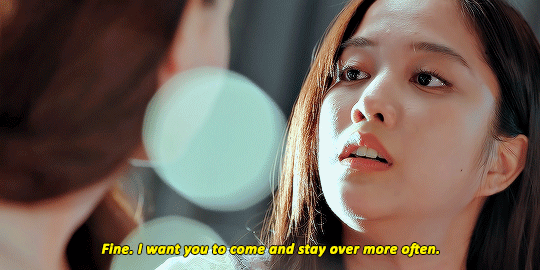
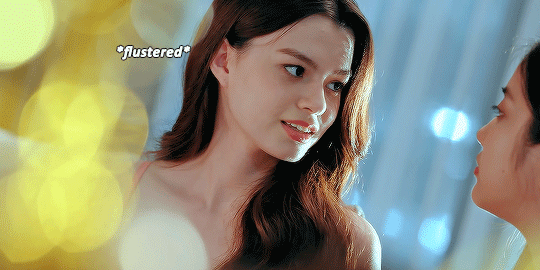

sam being honest and making mon shy (pt.1/?)
#gap the series#gap#wlwedit#wlwdaily#wlwgif#monsam#asiansapphics#asianlgbtqdramas#sam lying that girls do this to each other like????#my gif#like no they dont????#not to my knowledge anyway...
856 notes
·
View notes
Text
#im just really curious about this#because ive polled my acquantiances and the responses are varied#as a kid i definitely assumed they wrote it until i reaaaaaaally got into them and i Think most people assume that but im not sure#if ur a tmbg fan and u didnt know this im not judging u u can be honest.#because sometimes you do just have those really random knowledge gaps#i have a few things with tmbg where im like how did i go this long without knowing this although im blanking rn but there definitely were a#few recent examples#but i dont think theres many fans who dont know this but you never know so i put the option
23 notes
·
View notes
Text
How many times do we think Tommy has seen Airplane!
#the first time he makes a don't call me shirley joke evan is confused#tommy stares at him and realizes...with dawning horror......#most gaps in evan's pop culture knowledge can be dealt with on designated movie nights#but this one CANNOT STAND#evan put your shirt back on we're watching cinematic masterpiece airplane! (1980) RIGHT now#911#bucktommy#tommy kinard#tommy has it memorized i'm telling you
21 notes
·
View notes